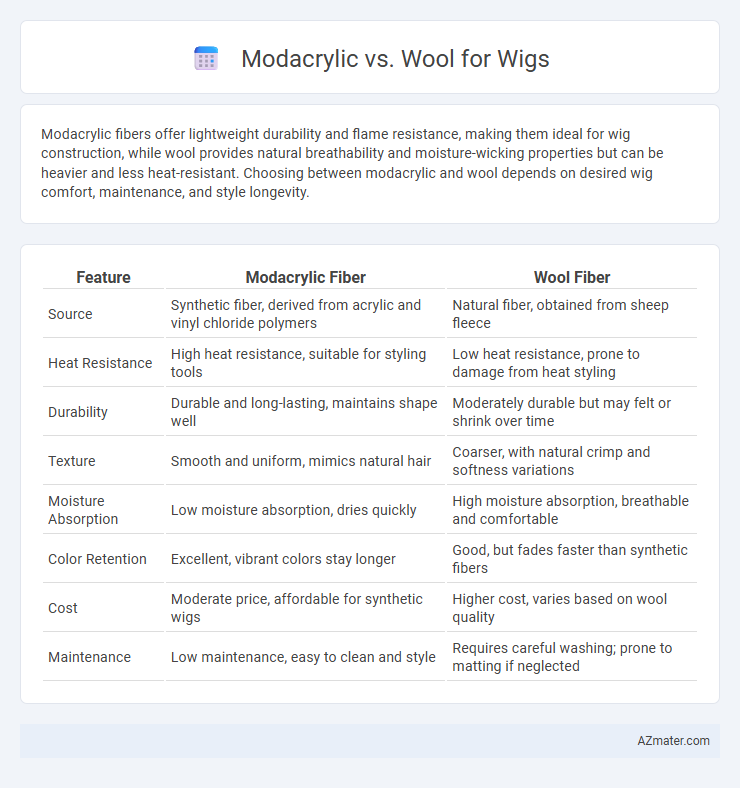Modacrylic fibers offer lightweight durability and flame resistance, making them ideal for wig construction, while wool provides natural breathability and moisture-wicking properties but can be heavier and less heat-resistant. Choosing between modacrylic and wool depends on desired wig comfort, maintenance, and style longevity.
Table of Comparison
| Feature | Modacrylic Fiber | Wool Fiber |
|---|---|---|
| Source | Synthetic fiber, derived from acrylic and vinyl chloride polymers | Natural fiber, obtained from sheep fleece |
| Heat Resistance | High heat resistance, suitable for styling tools | Low heat resistance, prone to damage from heat styling |
| Durability | Durable and long-lasting, maintains shape well | Moderately durable but may felt or shrink over time |
| Texture | Smooth and uniform, mimics natural hair | Coarser, with natural crimp and softness variations |
| Moisture Absorption | Low moisture absorption, dries quickly | High moisture absorption, breathable and comfortable |
| Color Retention | Excellent, vibrant colors stay longer | Good, but fades faster than synthetic fibers |
| Cost | Moderate price, affordable for synthetic wigs | Higher cost, varies based on wool quality |
| Maintenance | Low maintenance, easy to clean and style | Requires careful washing; prone to matting if neglected |
Introduction to Modacrylic and Wool Wigs
Modacrylic fibers are synthetic materials known for their lightweight, heat resistance, and natural appearance, making them a popular choice for affordable, easy-to-maintain wigs. Wool wigs, crafted from natural animal fibers, offer exceptional warmth, breathability, and a unique texture often preferred for a more authentic and resilient wig experience. Both modacrylic and wool wigs serve distinct purposes, with modacrylic excelling in low-cost versatility and wool providing superior comfort and durability for long-term wear.
Fiber Composition: Modacrylic vs Wool
Modacrylic fibers are synthetic polymers primarily composed of acrylonitrile combined with other chemical compounds, offering durability, flame resistance, and ease of styling for wigs. Wool fibers, derived from the natural protein keratin found in sheep's fleece, provide excellent breathability, elasticity, and a natural appearance but require more careful maintenance. The choice between modacrylic and wool fibers for wigs depends on desired texture, durability, and care preferences, with modacrylic excelling in synthetic resilience and wool offering superior natural comfort.
Appearance and Texture Differences
Modacrylic fibers used in wigs offer a smooth, shiny appearance with a consistent texture that mimics natural hair, while wool wigs tend to have a coarser, matte finish with more visible fiber irregularities. Modacrylic wigs provide a lightweight, soft feel and maintain their shape well after styling, contrasting with wool wigs which can feel heavier and have a denser, slightly rough texture. The synthetic nature of modacrylic often results in a more uniform and polished look compared to the organic, varied texture typical of wool wigs.
Durability and Lifespan Comparison
Modacrylic fibers offer enhanced durability for wigs, resisting heat, moisture, and chemicals better than natural wool, which is prone to wear and matting over time. Wool wigs tend to have a shorter lifespan due to their susceptibility to damage from environmental factors and regular styling processes. Modacrylic wigs maintain their shape and texture longer, making them a more durable and long-lasting option compared to wool-based wigs.
Comfort and Breathability
Modacrylic fibers in wigs offer lightweight comfort and excellent moisture resistance, making them less prone to irritation and suitable for sensitive scalps. Wool, while naturally breathable and warm, can retain moisture and may cause discomfort or itchiness when worn for extended periods. Choosing modacrylic wigs provides superior breathability and comfort, especially in warm or humid conditions, compared to wool-based alternatives.
Styling Versatility and Maintenance
Modacrylic fibers offer superior styling versatility compared to wool, allowing for heat styling tools to be used without damage, which is essential for creating diverse wig looks. Wool wigs tend to be less flexible in styling due to their natural fiber properties, requiring gentle care and avoiding excessive heat to maintain shape. Maintenance for modacrylic wigs is simpler as they are resistant to frizz and retain style longer, while wool wigs demand regular conditioning and delicate handling to prevent matting and fiber breakage.
Heat Resistance and Safety
Modacrylic fibers exhibit superior heat resistance compared to wool, making modacrylic wigs safer for heat styling tools such as curling irons and flat irons. Wool wigs, while natural and breathable, tend to have lower tolerance to high temperatures, increasing the risk of fiber damage or combustion during heat exposure. Choosing modacrylic wigs enhances durability and reduces fire hazards, providing safer options for daily wear and styling.
Allergenicity and Skin Sensitivity
Modacrylic fibers are hypoallergenic and less likely to cause skin irritation, making them a preferred choice for individuals with sensitive skin or allergies when selecting wig materials. Wool, while natural and breathable, can sometimes trigger allergic reactions and cause itchiness or discomfort for users with skin sensitivities. Choosing modacrylic wigs reduces the risk of dermatitis and enhances comfort for prolonged wear in comparison to wool-based wigs.
Price and Value Considerations
Modacrylic wigs generally offer a more affordable price point compared to wool-based wigs, making them a cost-effective choice for budget-conscious buyers. Wool wigs, while typically more expensive, provide superior breathability and natural texture that contribute to long-term value and comfort. Evaluating the balance between upfront cost and material benefits helps consumers select the best option for their needs and budget.
Choosing Between Modacrylic and Wool for Your Wig
Choosing between modacrylic and wool for your wig depends on factors like durability, comfort, and style preference. Modacrylic fibers offer heat resistance and easy maintenance, making them ideal for everyday use and styled looks, while wool provides natural breathability and warmth, enhancing comfort, especially in colder climates. Consider your lifestyle and desired wig appearance to select the material that best fits your needs.

Infographic: Modacrylic vs Wool for Wig
 azmater.com
azmater.com